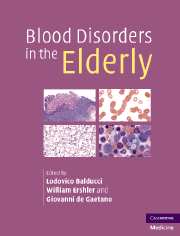Book contents
- Frontmatter
- Contents
- List of contributors
- Preface
- Part I Epidemiology
- Part II Hematopoiesis
- 5 Stem cell exhaustion and aging
- 6 Hematopoietic microenvironment and age
- 7 Replicative senescence, aging, and cancer
- 8 Qualitative changes of hematopoiesis
- 9 Aging and hematopoietic stress
- 10 Immunoglobulin response and aging
- 11 Biological and clinical significance of monoclonal gammopathy
- Part III Anemia of aging
- Part IV Hematologic malignancies and aging
- Part V Disorders of hemostasis in the elderly
- Index
5 - Stem cell exhaustion and aging
from Part II - Hematopoiesis
Published online by Cambridge University Press: 21 October 2009
- Frontmatter
- Contents
- List of contributors
- Preface
- Part I Epidemiology
- Part II Hematopoiesis
- 5 Stem cell exhaustion and aging
- 6 Hematopoietic microenvironment and age
- 7 Replicative senescence, aging, and cancer
- 8 Qualitative changes of hematopoiesis
- 9 Aging and hematopoietic stress
- 10 Immunoglobulin response and aging
- 11 Biological and clinical significance of monoclonal gammopathy
- Part III Anemia of aging
- Part IV Hematologic malignancies and aging
- Part V Disorders of hemostasis in the elderly
- Index
Summary
Do hematopoietic stem cells show age-related loss of function?
The production of over 4 × 1015 erythrocytes, lymphocytes, and myeloid cells during the lifetime of an individual rests on the shoulders of the hematopoietic stem cell (HSC). While the demand placed upon the HSC may seem Sisyphean in its magnitude, it is hardly a futile endeavor. For instance, a single HSC can repopulate the entire hematopoietic system of a lethally irradiated mouse, and engraftment levels after secondary transplanation mirror those of the primary recipients. While other transplantation protocols show that the numbers of primitive cells in the bone marrow (BM) of recipients remain depressed permanently, circulating blood cell numbers are not significantly different from non-transplanted mice. This is a profound statement of the ability of these pluripotent stem cells to proliferate, differentiate, and perhaps most importantly, self-renew. Furthermore, BM cells can be serially transplanted up to five times before the marrow grafts fail to sustain hematopoiesis. The transplantation process places extreme demand on the HSC population that is not encountered during normal aging, which leads to the suggestion that mouse BM cells have sufficient proliferative capacity to sustain hematopoiesis over multiple mouse lifespans. Even more confounding is the finding by our laboratory and others that the absolute number of HSCs does not decrease but actually increases during the lifetime of the widely used C57BL/6 (B6) mouse strain.
- Type
- Chapter
- Information
- Blood Disorders in the Elderly , pp. 57 - 70Publisher: Cambridge University PressPrint publication year: 2007

